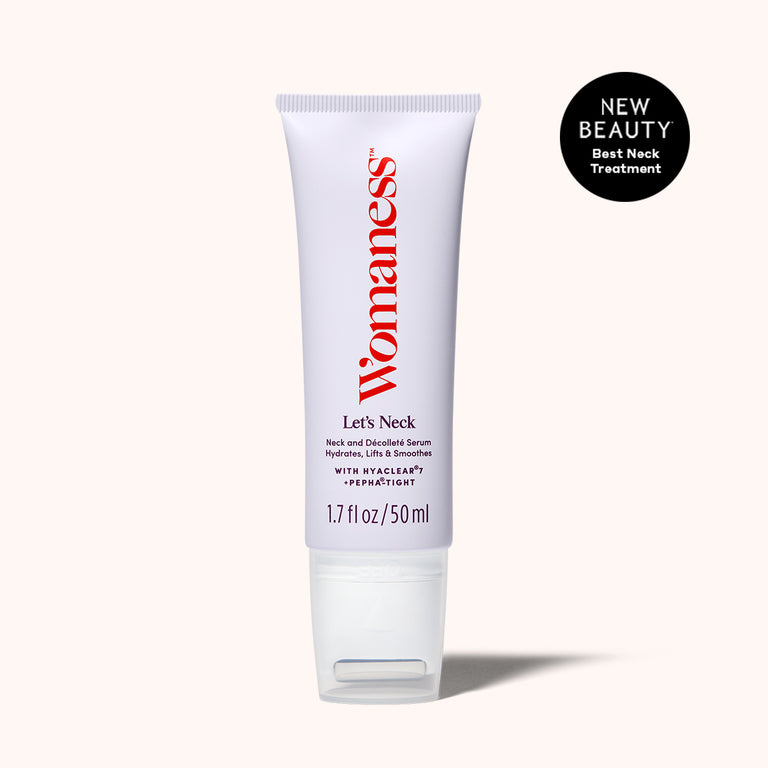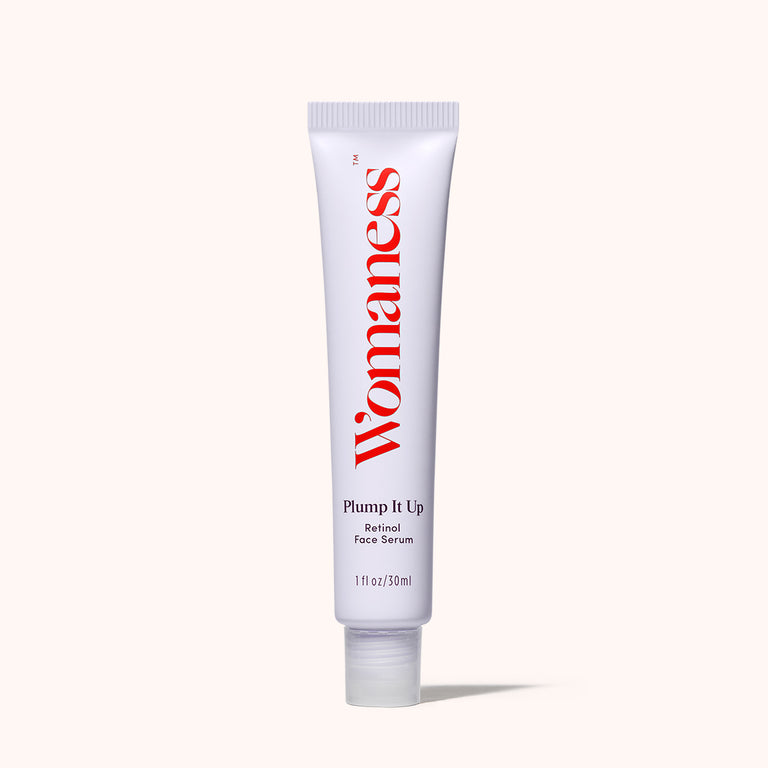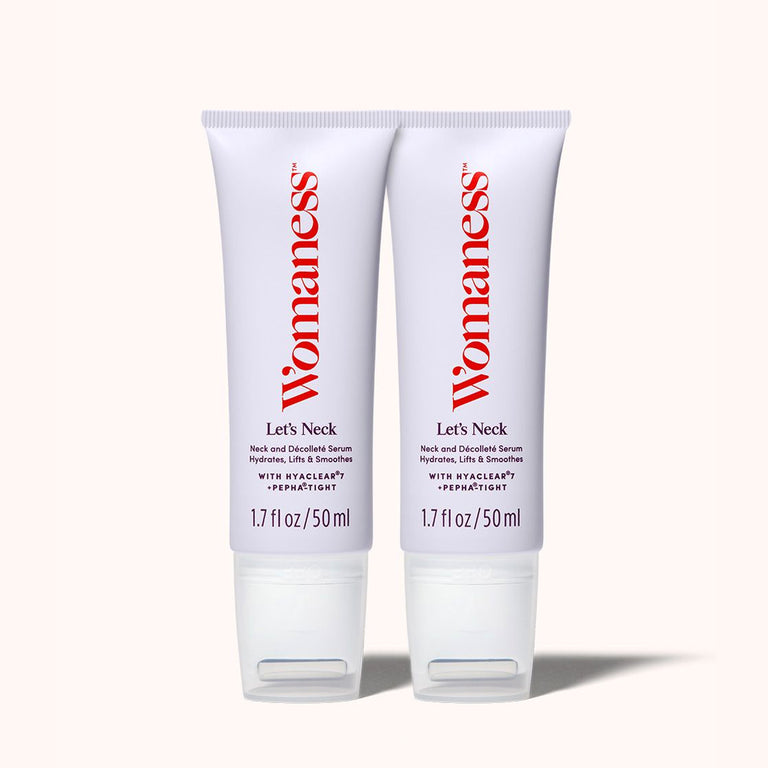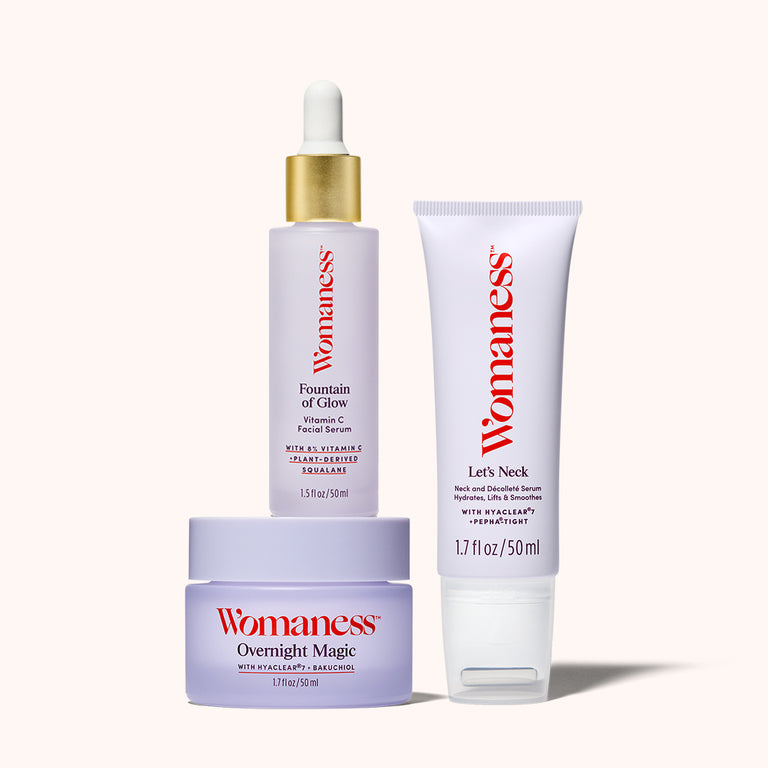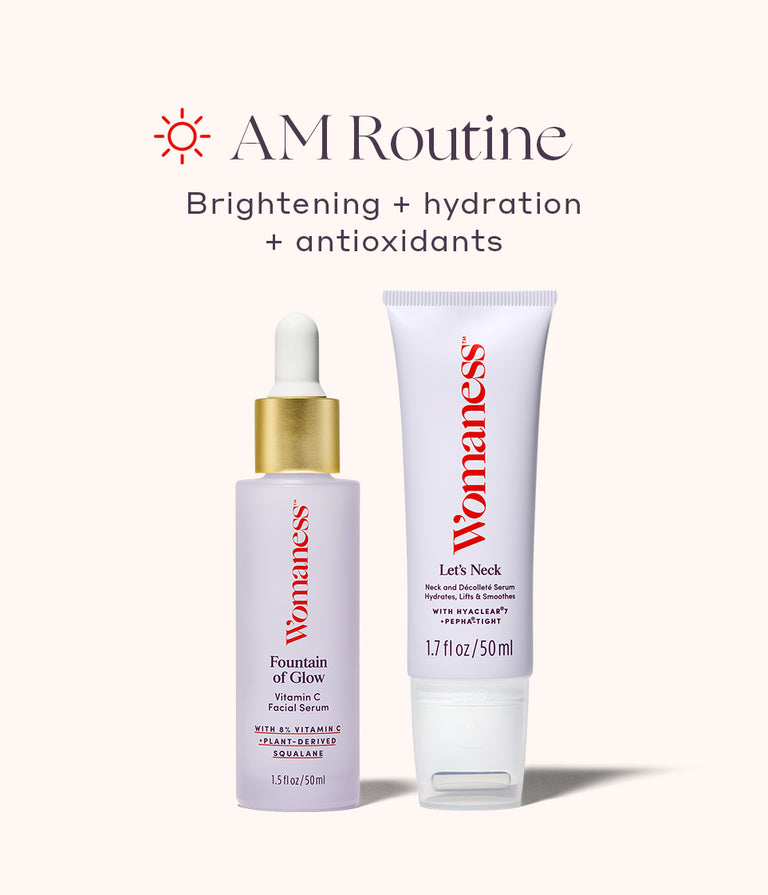By Michelle Jacobs 3-Minute Read

Crepey neck skin—it happens to all of us. It isn’t a topic that garners as much attention as wrinkles or sun spots, but most women are still thinking about it.
As we age, skin elasticity decreases, making it harder for your skin to bounce back, leading to that "crepey" look, especially in areas exposed to the sun regularly. We spend our lives putting SPF on our face and suddenly realize we forgot our neck!
But worry not: it's not irreversible, but prevention is possible with the right approach.
By the end of this guide, you'll have a good grasp on the steps you can take to manage and prevent crepey skin and get yourself ready to put on a strapless dress (or at least a v-neck sweater for fall!).
What causes loose, crepey skin on the neck?
Crepey skin, characterized by a thin, wrinkled surface reminiscent of crepe paper, is a common consequence of aging. It tends to appear in areas exposed to the sun most frequently, such as the neck.
The primary factors causing crepey skin include ultraviolet ray damage and loss of moisture. According to researchers, prolonged exposure to the sun's light, especially harmful UV rays, can degrade the skin's elasticity over time. Additionally, as we age, our skin's ability to retain moisture decreases, contributing to a crepey texture.
Other factors like smoking, rapid weight loss, environmental pollution, and using your phone too much (hello, Tech Neck!) can also contribute to the development of crepey skin.
How can you treat crepey skin on the neck?
While it's challenging to entirely reverse the appearance of crepey skin, certain skincare routines and treatments can help improve its appearance. Emollients and hydroxy acid cleansers, for example, can help keep the skin moisturized and gently exfoliate to promote smoother skin.
Additionally, body moisturizers containing elastin stimulator ingredients, such as retinol and hydroxy acids, can also be beneficial. These ingredients promote the production of elastin, a protein that helps maintain skin elasticity and firmness.
Increasing water intake can also be beneficial as hydrated skin is generally healthier and more resilient. In more severe cases, clinical treatments like using a radiofrequency device, ultrasound, or pulsed light device, often known as laser treatment, may be recommended by dermatologists.
Are there preventive measures for crepey skin?
While aging is inevitable, there are several preventive measures that you can take to delay the onset of crepey skin. One of the most effective strategies is protecting your skin from the sun. This can be achieved through using broad-spectrum sunscreens, wearing protective clothing, and limiting sun exposure during peak hours.
DEBUNKING MYTHS ABOUT CREPEY NECK SKIN
When it comes to crepey neck skin, there are many misconceptions that can lead to confusion and misinformed skincare routines. Let's debunk some of these common myths and provide the accurate information you need to properly care for your skin.
Myth 1: Only older women get crepey skin
This is incorrect. While age is indeed a significant factor in the development of crepey skin, it's not the only one. Crepey skin can also develop due to excessive sun exposure, environmental pollutants, and lifestyle habits like smoking and poor diet. Tech Neck develops from using your phone too much. And people of all ages can develop Tech Neck.
Myth 2: Moisturizing alone can prevent crepey skin
This is not entirely true. While moisturizing is essential for maintaining skin elasticity and preventing dryness, it's just one aspect of comprehensive skincare. Protection from UV rays, a healthy diet, adequate hydration, and regular exercise also play significant roles in preventing crepey skin. Even with the best moisturizer, neglecting these other factors can still lead to skin damage.
Myth 3: Crepey skin can't be improved
While it's challenging to reverse crepey skin completely, this doesn't mean improvements can't be made. A combination of a good skincare routine and certain treatments can significantly improve the appearance of crepey skin. These treatments include emollients, hydroxy acid cleansers, and body moisturizers containing elastin stimulator ingredients. In more severe cases, procedures like radiofrequency therapy, ultrasound, or laser treatment can provide substantial improvement.
Myth 4: Drinking water will directly hydrate your skin
While drinking water is essential for overall health, it's not as straightforward when it comes to directly hydrating the skin. While staying well-hydrated can support skin health indirectly, applying moisturizers and using skincare products designed to lock in moisture can have a more direct impact on skin hydration. That being said, maintaining a healthy water intake is always a beneficial practice.
Myth 5: Crepey skin is the same as wrinkled skin
Although they are often confused, crepey skin and wrinkles are not the same. Wrinkles typically form as lines or folds in response to facial expressions or gravity. On the other hand, crepey skin is characterized by a more widespread thinning of the skin, giving it a finely wrinkled appearance similar to crepe paper. This can occur on various parts of the body, not just the face, and is usually due to a general loss of elasticity and collagen.
Myth 6: All skincare products can prevent crepey skin
Not all skincare products are created equal when it comes to preventing or improving crepey skin. The effectiveness of a product depends on its ingredients and your skin type. Products containing retinol, hydroxy acids, and elastin stimulators are often beneficial for crepey skin. However, it's essential to consult with a dermatologist or skincare expert to find the most suitable products for your unique skin needs.
Myth 7: Sunscreen isn't needed on cloudy days
Contrary to this common belief, UV rays can penetrate through clouds and harm your skin, even on cloudy or cold days. UV damage is a significant factor in the development of crepey skin. Thus, wearing a broad-spectrum sunscreen, even on cloudy days, is essential for protecting your skin from UV damage.

4 STEPS TO IMPROVE THE LOOK OF CREPEY NECK SKIN
At Womaness, we recommend a 4-step routine for preventing and improving the look of crepey neck skin. All four of these products help your skin feel hydrated and moisturized. Plus, they help reduce the appearance of age spots and brighten and smooth skin’s texture.
1. Let’s Neck
This cult-favorite neck and décolleté serum with a soothing stainless-steel rollerball is full of hydrating ingredients that help keep skin moisture locked in for over 24 hours:
HYACLEAR® 7: A superior combination of seven powerful types of sodium hyaluronate—derived from hyaluronic acid—which optimizes moisturization to enhance the appearance of elasticity and firmness. This advanced form of hyaluronic acid is a heroine of hydration.
PEPHA-TIGHT®: A microalgae extract that forms a thin film on your skin, delivering an instant tightening experience. Over time with daily usage, it helps provide a firming effect, protect your skin from oxidative stress, and strengthen its moisture barrier.
EMBLICA: Used for centuries in Ayurvedic healing, this extract from the amla fruit—also known as the Indian gooseberry—is a naturally potent antioxidant known for brightening and evening your skin. It’s been shown to reduce wrinkles and the visibility of freckles and age spots, and help your skin retain its natural moisture.
See below for before and after results after consistent use for four weeks of Let's Neck:

2. Plump It Up
This gentle, supercharged formula of 0.3% retinol plus moisture-replenishing hyaluronic acid and ceramide NG helps smooth fine lines, fade discoloration, and boost the elasticity of a changing complexion. Again, our rollerball technology allows you to spot treat your deepest lines and darkest age spots.
Its ingredients list includes:
RETINOL: A form of vitamin A that helps strengthen your skin, smooth its texture, and reduce fine lines and wrinkles.
HYALURONIC ACID: A beneficial molecule produced by your body deep in the dermis that supports skin’s ability to maintain hydration.
CERAMIDE NG: A lipid produced naturally by your body that improves the way your skin retains water and keeps it supple, smooth, and hydrated.
3. Brighten Up
This gentle yet effective exfoliating toner sloughs away dead skin cells, refines pore, smooths skin, and helps reduce the look of dark spots thanks to a triple acid complex of three types of chemical exfoliants and other plant-based ingredients:
LACTIC ACID (AHA): An alpha hydroxy acid (AHA) that exfoliates the surface of the skin while encouraging cellular turnover and brightening skin tone. It also helps keep skin hydrated due to its ability to bind water within skin.
SALICYLIC ACID (BHA): Also called beta hydroxy acid or BHA, this oil soluble acid mimics the natural exfoliation process of younger skin by unclogging and clearing pores, exfoliating the buildup of dull, dead skin on the skin’s surface. It also helps clear and control excess oil production without dryness or irritation and reduces the appearance of pores.
BROMELAIN (PHA): The gentlest acid in the group, this PHA is an enzyme found in the pineapple plant that soothes skin while buffing away dead skin cells to leave your skin smoother and brighter.
BILBERRY FRUIT/LEAF EXTRACT: Also known as European Wild Blueberries, Bilberries strengthen the skin against signs of redness, boost skin’s environmental defenses against UVA light, and are an incredible source of antioxidants.
FRUIT ACIDS: Including Saccharum Officinarum (Sugar Cane) Extract, Citrus Limon (Lemon) Fruit Extract, Acer Saccharum (Sugar Maple) Extract, and Citrus Aurantium Dulcis (Orange) Fruit Extract, these extracts provide a gentler form of cell turnover while still providing exfoliation.
4. Fountain of Glow
Use this serum to revive a changing complexion and help naturally brighten, hydrate, and condition to improve the appearance of dull skin from your changing hormones.
It also helps boost collagen production and fade spots thanks to a breakthrough super-antioxidant formula of 8% vitamin C in a naturally derived squalane oil with benefits you'll love:
VITAMIN C: The champion of menopausal skin. It helps hydrate, brighten, even skin tone, and improve texture. Plus, it helps boost collagen production and fade spots. A stable oil-soluble type is used in this serum for high potency and low irritation.
SQUALANE: A plant-derived, weightless emollient that locks in moisture and reduces the appearance of fine lines and wrinkles. It’s an excellent antioxidant to help protect skin from the effects of free radicals.
Embrace your age with confidence, knowing that crepey neck skin is a natural part of life, but not an unmanageable one. With the right balance of prevention, treatments, and an understanding of the truths (and myths!) out there, you can take control of your skin's appearance. Whether it's through the daily use of naturally formulated products like Let's Neck, Plump It Up, Brighten Up, and Fountain of Glow, or adopting healthy habits that protect and nourish your skin, your path to smoother, firmer skin you want is just a few thoughtful steps away. And just remember, your skin tells a story—and with the guidance and solutions offered here at Womaness, you can ensure it's one of radiant resilience.
More For You
Ingredient Spotlight: Hyaluronic Acid
7 Genius Beauty Hacks We Can't Get Enough Of
What's Happening Here? Changes in Skin, Hair, & Nails

